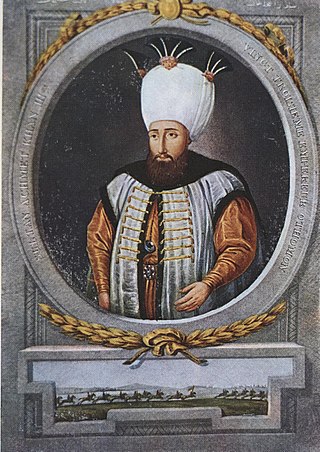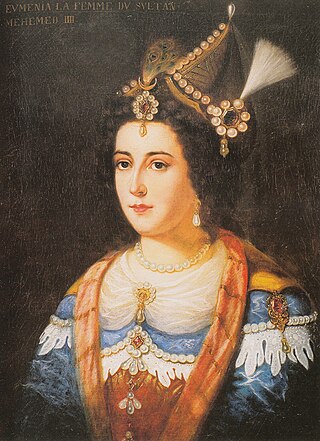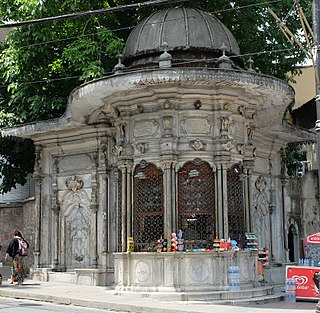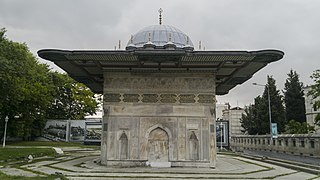
Following is a list of notable fountain in Istanbul, Turkey:

Following is a list of notable fountain in Istanbul, Turkey:

Ahmed III was sultan of the Ottoman Empire and a son of sultan Mehmed IV. His mother was Gülnuş Sultan, originally named Evmania Voria, who was an ethnic Greek. He was born at Hacıoğlu Pazarcık, in Dobruja. He succeeded to the throne in 1703 on the abdication of his brother Mustafa II (1695–1703). Nevşehirli Damat İbrahim Pasha and the Sultan's daughter, Fatma Sultan directed the government from 1718 to 1730, a period referred to as the Tulip Era.

Abdulhamid or Abdul Hamid I was the 27th sultan of the Ottoman Empire from 1774 to 1789.

The Topkapı Palace, or the Seraglio, is a large museum and library in the east of the Fatih district of Istanbul in Turkey. From the 1460s to the completion of Dolmabahçe Palace in 1856, it served as the administrative center of the Ottoman Empire, and was the main residence of its sultans.

The Tulip Period, or Tulip Era, is a period in Ottoman history from the Treaty of Passarowitz on 21 July 1718 to the Patrona Halil Revolt on 28 September 1730. This was a relatively peaceful period, during which the Ottoman Empire began to orient itself outwards.

Nevşehirli Damat Ibrahim Pasha served as Grand Vizier for Sultan Ahmed III of the Ottoman Empire during the Tulip period. He was also the head of a ruling family which had great influence in the court of Ahmed III. The epithet "Nevşehirli" is used to distinguish this Grand Vizier from another, Damat Ibrahim Pasha.

The Zeynep Sultan Mosque is a mosque built in 1769 by Ayazma Mosque's architect Mehmet Tahir Ağa for Ahmed III's daughter Zeynep Sultan. It evokes Byzantine churches because of its architectural style and materials that were used in its construction.

The Fountain of Sultan Ahmed III is a fountain in the great square in front of the Imperial Gate of Topkapı Palace in Istanbul, Turkey. It was built under Ottoman sultan Ahmed III in 1728, in the style of the Tulip period. It was a social centre and gathering place during the Ottoman period of Constantinople.

Emetullah Rabia Gülnuş Sultan was the Haseki Sultan of Ottoman Sultan Mehmed IV and Valide sultan to their sons Mustafa II and Ahmed III. In the early 18th century, she became one of the most powerful and influential woman in the Ottoman Empire.

Rabia Şermi Kadın was a consort of Sultan Ahmed III and the mother of Sultan Abdul Hamid I.
Ayşe Sineperver Sultan, also known as Ayşe Sineperver Kadın, was a consort of Ottoman Sultan Abdul Hamid I, and Valide Sultan to their son Sultan Mustafa IV of the Ottoman Empire.

A sabil or sebil is a small kiosk in the Islamic architectural tradition where water is freely dispensed to members of the public by an attendant behind a grilled window. The term is sometimes also used to refer to simple unmanned fountains with a tap for drinking water, though other names often exist for such fountains.

The Fountain of Sultan Ahmed III in Üsküdar is an 18th-century public water fountain built by Ottoman sultan Ahmed III in the Ottoman rococo architecture and situated in the grand square of Üsküdar in Istanbul, Turkey.

Tophane Fountain is an 18th-century public water fountain built by Ottoman sultan Mahmud I in the Ottoman rococo architecture and situated in the square of Tophane neighborhood in Beyoğlu district of Istanbul, Turkey.
Fatma Sultan, was an Ottoman princess, daughter of Sultan Ahmed III and his BaşKadin Emetullah Kadın. She was politically active and influential on the affairs of state during the late Tulip era (1703–1730).

Emine Mihrişah Kadın was a consort of Sultan Ahmed III and the mother of Sultan Mustafa III.
Safiye Sultan was an Ottoman princess, daughter of Sultan Mustafa II, and half-sister of Sultans Mahmud I and Osman III of the Ottoman Empire.
Atike Sultan was an Ottoman princess, the daughter of Sultan Ahmed III. She was half-sister of Mustafa III and Abdul Hamid I.
Hatice Sultan was an Ottoman princess, the daughter of Sultan Ahmed III and one of his consorts, Rukiye Kadın.
Hatice Sultan was an Ottoman princess, the daughter of Mehmed IV, and his Haseki Emetullah Rabia Gülnuş Sultan. She was the sister of Sultans Mustafa II and Ahmed III.

Tulip Period architecture was a stage in Ottoman architecture in the early 18th century. New types of decoration were introduced into the existing classical style of Ottoman architecture and new types of buildings, such as stand-alone fountains and libraries, became important landmarks. The style is most closely associated with the Tulip Period (1718-1730), a period of peace during the reign of Ahmed III when architectural patronage increased in Istanbul after a relative lull in the late 17th century. However, the new style was also present at the beginning of Ahmed III's reign and continued to be evident after him in the 1730s. The introduction of European influences in Ottoman culture and architecture eventually led to the creation of the Ottoman Baroque style in the 1740s.